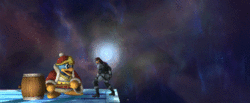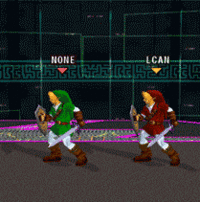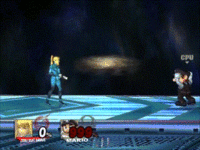Lag
- For the lag associated with playing online, see Wi-Fi lag. For the lag associated with certain televisions, see Display lag. For the lag associated with connecting with attacks, see Freeze frame. For the lag when aerial attacks land, see Landing lag.
Lag is a catch-all term used to indicate periods of time where a character is busy initiating or finishing a performed move, being left unable to perform in any other action (except for moving through the air with aerial moves). The two main categories of lag that every move in the game has are startup lag and ending lag, and for aerials and certain special moves when used in the air, there's an additional form of ending lag that can occur called landing lag. The more lag a move has, the easier it is to evade the attack and punish the user. Generally, more powerful KO moves have greater startup and/or ending lag.
Start-up lag
Start-up lag, also known as just start-up and windup, is the delay between a move being initiated and the move having an effect, such as the length of time before a hitbox is first produced. Examples of moves with extreme start-up lag include Ganondorf's Warlock Punch and King Dedede's forward smash. Examples of moves with no start-up lag include Fox's and Falco's Reflector in Melee and Jigglypuff's Rest. Flinching during start-up will prevent the move from being executed.
The primary advantage of lower start-up lag is that the attack gives the opponent less reaction time, as well as the ability to hit before other attacks, and the user greater flexibility in being able to land the attack (making such attacks all around easier to land). Characters having access to low start-up lag attacks is important for success in competitive play; part of the reason Pikachu in Smash 64, Fox and Falco in Melee, and Meta Knight in Brawl are considered the best characters in their respective games is that the general start-up lag of their attacks is among the fastest. Conversely, a major part of why Bowser in Melee and Ganondorf in Brawl have always been considered bottom tier characters is that the general start-up lag of their attacks are the worst in their respective games.
Ending lag

Ending lag, also known as cool down, is the delay between the move's effect finishing and another action being available to begin, such as the length of time after an attack's hitboxes ceases that the character can move again. Almost all attacks have more ending lag than startup lag, though generally, attacks with lower start-up lag tend to have proportionally more ending lag and vice versa. Attacks such as Rest and Ike's forward smash are notorious for having an extreme amount of ending lag. Moves known for having especially low ending lag include Meta Knight's up aerial and Lucario's forward smash. Typically an attack's ending lag can't be avoided, but some attacks can avoid ending lag without the character being flinched or out-prioritised, such as grabbing a ledge with a recovery move before it ends, and jump cancelling Fox's and Falco's Reflector in Melee. Additionally, aerials can avoid their ending lag by the character landing before completion; despite this inducing landing lag, it can be overall faster if the character lands soon enough and the attack's landing lag is low enough (a prominent example of this is Ike's neutral aerial in Brawl, which has a huge amount of ending lag, but rather low landing lag, thus landing earlier can be utilised to circumvent the attack's high ending lag). Also, if a character using a standard land attack is no longer on land before the attack finishes (such as from being pushed off by wind or the platform underneath them ceasing to exist), the attack will abruptly end with the user free to move, thus avoiding the attack's ending lag (special moves though will continue if this occurs while using them).
The primary advantage of lower ending lag is that the less ending lag there is, the less punishable the move is, thus the more safe it is to use. Since the attacks end sooner, low ending lag attacks are also more effective at comboing, as they allow a greater window to followup landed attacks before the opponent can respond properly or respond at all. While having attacks with low ending lag is considered important in competitive play and characters higher up on the tier list typically have lower ending lag attacks, it isn't held in equal regard to start-up lag is. Marth, for example, is considered a top/high tier character in both Melee and Brawl, despite most of his attacks having high ending lag, while there are no characters in any of the games ranked high that has comparatively high start-up lag attacks. More attacks can be very effective in spite of high ending lag (Jigglypuff's Rest in Melee being the most notorious example of such, as despite its ridiculously high ending lag and small hitbox, its start-up lag of 1 frame makes the move very landable, where its extreme power can be utilised), while there are few attacks that can be very effective in spite of high start-up lag. For example, Ganondorf's up tilt in both games is an extreme power attack with a small hitbox that has proportionally low ending lag, but its start-up lag is so ridiculously high the move is almost impossible to land without the opponent being incapacitated, and its extreme power can realistically never be utilised. Moves that are very effective in spite of high start-up lag have a combination of significant attributes beyond just low ending lag (the aforementioned f-smash of Lucario's is considered to be one of the best f-smashes in Brawl despite being one of the slowest in start-up, as the move not only has very low ending lag, but also has potential extreme power with great reach, making it one of the few powerful KO moves that can often be used with no repercussions if it fails to land).
Landing lag

Landing lag occurs when a character in the middle of an aerial attack lands on the ground, resulting in a longer-than-usual landing animation. A clear example is Link's down aerial; hitting the ground during the attack results in Link's sword getting stuck, and he has to spend a significant amount of time pulling it out before he can do anything else. Each aerial attack has its own amount of landing lag; most special moves tend to continue execution instead of being interrupted when the user lands. L-cancelling will reduce landing lag, while auto-cancelling will avoid it.
In Smash 64, not all aerial attacks have unique landing animations.
Types of landing lag
All of the following animations are counted as landing to the game and thus refill special moves like Marth's side special semi-jump, tether recoveries and the likes. All of these can be ledge-cancelled.
Impact landing
This landing animation occurs when landing on a frame of an empty jump or on an auto-cancel frame. This also includes jumping, performing an aerial and landing after it has ended completely. For most characters, this animation can be interrupted with every action after 4 frames. Only a few characters take longer, for example Ganondorf (5 frames) and Bowser (6 frames) The total animation length is 30 frames for all characters.
No-impact landing
The 4 frames landing lag can be circumvented by landing at the peak of the jump or by platforms that move upwards faster than the character. As soon as the character collides with the platform, he immediately stands and can do any move. The landing lag decreases to 1 frame that way.
Aerial landing lag
All aerials have a specific landing animation of certain durations and all of them can be L-cancelled. The only exception to this are Mr. Game & Watch's neutral-, back-, and up-aerials, which, due to a programming quirk have special landing lag that cannot be L-cancelled.
Special landing lag
Airdodges and thus also wavelands and wavedashes always end with this landing animation, and so do most recovery attacks. There is only one »LANDINGFALLSPECIAL« animation for every character that is played with varying speed depending on the move used.


